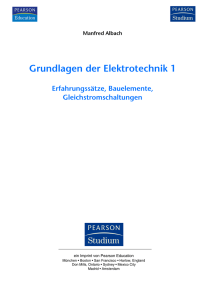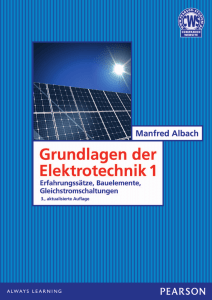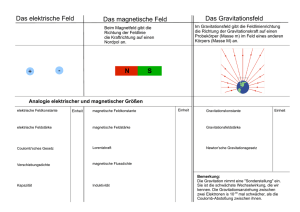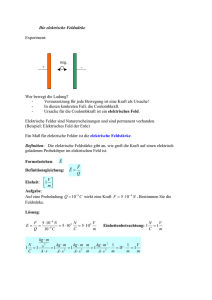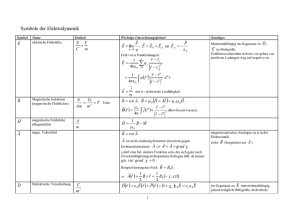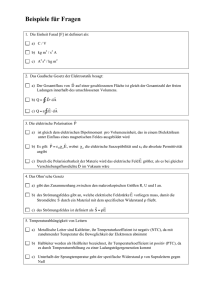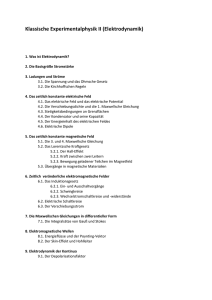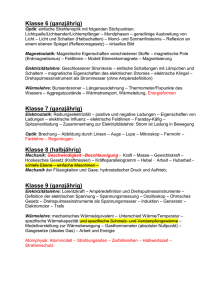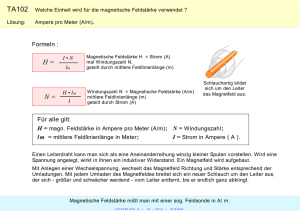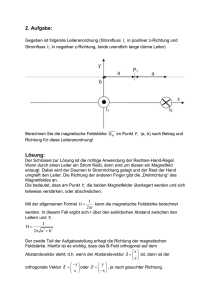Grundlagen der Elektrotechnik 1 - *ISBN 978
Werbung
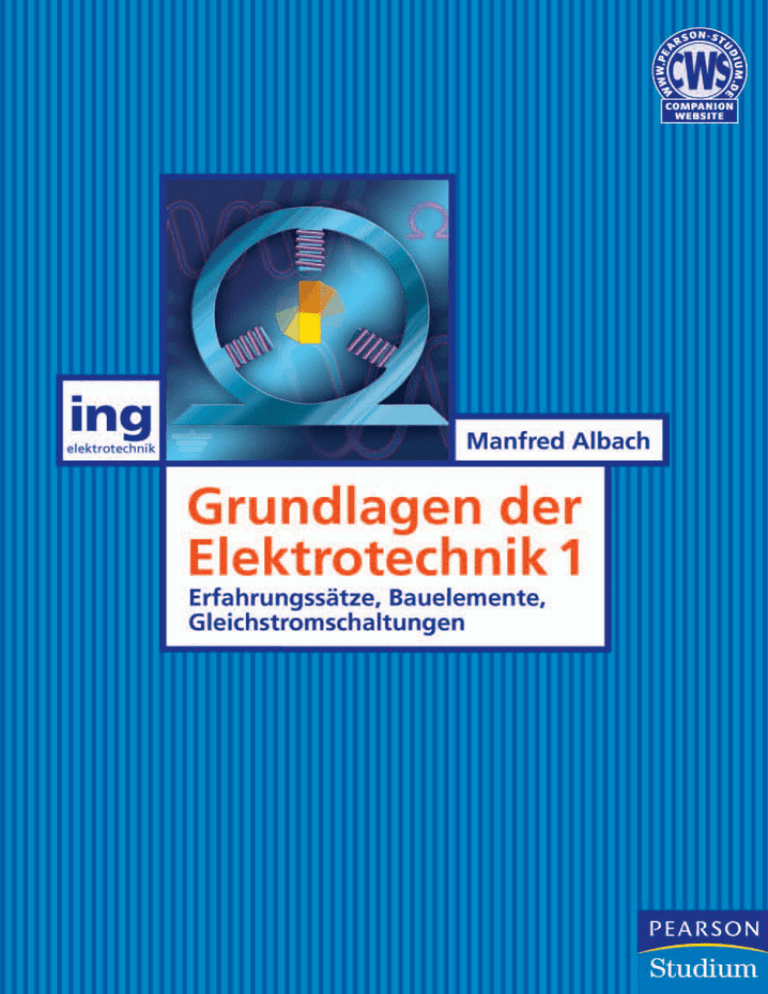
Inhaltsverzeichnis Vorwort Kapitel 1 1.1 1.2 1.3 1.4 1.5 1.6 1.7 1.8 1.9 1.10 1.11 1.12 1.13 1.14 1.15 1.16 1.17 1.18 1.19 1.20 1.21 Das elektrostatische Feld Die elektrische Ladung . . . . . . . . . . . . . . . . . . . . . . . . . . . . . . . . . . . . . . . . . Das Coulomb’sche Gesetz . . . . . . . . . . . . . . . . . . . . . . . . . . . . . . . . . . . . . . . Die elektrische Feldstärke . . . . . . . . . . . . . . . . . . . . . . . . . . . . . . . . . . . . . . . Überlagerung von Feldern . . . . . . . . . . . . . . . . . . . . . . . . . . . . . . . . . . . . . . . Kräfte zwischen Ladungsverteilungen . . . . . . . . . . . . . . . . . . . . . . . . . . . . . Ladungsdichten . . . . . . . . . . . . . . . . . . . . . . . . . . . . . . . . . . . . . . . . . . . . . . . Darstellung von Feldern . . . . . . . . . . . . . . . . . . . . . . . . . . . . . . . . . . . . . . . . 1.7.1 Feldbild für zwei Punktladungen . . . . . . . . . . . . . . . . . . . . . . . . . . 1.7.2 Qualitative Darstellung von Feldbildern . . . . . . . . . . . . . . . . . . . . . Das elektrostatische Potential . . . . . . . . . . . . . . . . . . . . . . . . . . . . . . . . . . . . 1.8.1 Das Potential einer Punktladung . . . . . . . . . . . . . . . . . . . . . . . . . . . 1.8.2 Äquipotentialflächen . . . . . . . . . . . . . . . . . . . . . . . . . . . . . . . . . . . . Die elektrische Spannung . . . . . . . . . . . . . . . . . . . . . . . . . . . . . . . . . . . . . . . Die elektrische Flussdichte . . . . . . . . . . . . . . . . . . . . . . . . . . . . . . . . . . . . . . Das Verhalten der Feldgrößen bei einer Flächenladung. . . . . . . . . . . . . . . . Feldstärke an leitenden Oberflächen. . . . . . . . . . . . . . . . . . . . . . . . . . . . . . . Die Influenz . . . . . . . . . . . . . . . . . . . . . . . . . . . . . . . . . . . . . . . . . . . . . . . . . . 1.13.1 Dünne leitende Platten im homogenen Feld . . . . . . . . . . . . . . . . . . 1.13.2 Im leitenden Körper eingeschlossener Hohlraum. . . . . . . . . . . . . . Die dielektrische Polarisation . . . . . . . . . . . . . . . . . . . . . . . . . . . . . . . . . . . . Kräfte im inhomogenen Feld . . . . . . . . . . . . . . . . . . . . . . . . . . . . . . . . . . . . . Sprungstellen der Dielektrizitätskonstanten. . . . . . . . . . . . . . . . . . . . . . . . . Die Kapazität . . . . . . . . . . . . . . . . . . . . . . . . . . . . . . . . . . . . . . . . . . . . . . . . . 1.17.1 Der Plattenkondensator . . . . . . . . . . . . . . . . . . . . . . . . . . . . . . . . . . 1.17.2 Der Kugelkondensator . . . . . . . . . . . . . . . . . . . . . . . . . . . . . . . . . . . Einfache Kondensatornetzwerke . . . . . . . . . . . . . . . . . . . . . . . . . . . . . . . . . . Praktische Ausführungsformen von Kondensatoren . . . . . . . . . . . . . . . . . . 1.19.1 Der Vielschichtkondensator . . . . . . . . . . . . . . . . . . . . . . . . . . . . . . . 1.19.2 Der Drehkondensator . . . . . . . . . . . . . . . . . . . . . . . . . . . . . . . . . . . . 1.19.3 Der Wickelkondensator . . . . . . . . . . . . . . . . . . . . . . . . . . . . . . . . . . Die Teilkapazitäten. . . . . . . . . . . . . . . . . . . . . . . . . . . . . . . . . . . . . . . . . . . . . Der Energieinhalt des Feldes . . . . . . . . . . . . . . . . . . . . . . . . . . . . . . . . . . . . . Zusammenfassung . . . . . . . . . . . . . . . . . . . . . . . . . . . . . . . . . . . . . . . . . . . . . Übungsaufgaben . . . . . . . . . . . . . . . . . . . . . . . . . . . . . . . . . . . . . . . . . . . . . . . Kapitel 2 2.1 2.2 2.3 11 Das stationäre elektrische Strömungsfeld Der elektrische Strom. . . . . . . . . . . . . . . . . . . . . . . . . . . . . . . . . . . . . . . . . . . Die Stromdichte . . . . . . . . . . . . . . . . . . . . . . . . . . . . . . . . . . . . . . . . . . . . . . . Definition des stationären Strömungsfeldes . . . . . . . . . . . . . . . . . . . . . . . . . 15 17 18 19 21 24 26 27 29 31 31 34 36 37 38 41 45 47 47 49 51 57 58 60 61 62 65 67 67 68 69 69 70 74 75 79 81 83 86 Inhaltsverzeichnis 2.4 2.5 2.6 2.7 2.8 2.9 Ladungsträgerbewegung im Leiter . . . . . . . . . . . . . . . . . . . . . . . . . . . . . . . . Die spezifische Leitfähigkeit und der spezifische Widerstand . . . . . . . . . . Das Ohm’sche Gesetz . . . . . . . . . . . . . . . . . . . . . . . . . . . . . . . . . . . . . . . . . . Praktische Ausführungsformen von Widerständen . . . . . . . . . . . . . . . . . . 2.7.1 Festwiderstände . . . . . . . . . . . . . . . . . . . . . . . . . . . . . . . . . . . . . . . 2.7.2 Einstellbare Widerstände . . . . . . . . . . . . . . . . . . . . . . . . . . . . . . . . 2.7.3 Weitere Widerstände. . . . . . . . . . . . . . . . . . . . . . . . . . . . . . . . . . . . Das Verhalten der Feldgrößen an Grenzflächen . . . . . . . . . . . . . . . . . . . . . 2.8.1 Verschwindende Leitfähigkeit in einem Teilbereich . . . . . . . . . . 2.8.2 Perfekte Leitfähigkeit in einem Teilbereich . . . . . . . . . . . . . . . . . . Energie und Leistung . . . . . . . . . . . . . . . . . . . . . . . . . . . . . . . . . . . . . . . . . . Zusammenfassung . . . . . . . . . . . . . . . . . . . . . . . . . . . . . . . . . . . . . . . . . . . . Übungsaufgaben . . . . . . . . . . . . . . . . . . . . . . . . . . . . . . . . . . . . . . . . . . . . . . Kapitel 3 3.1 3.2 3.3 3.4 3.5 3.6 3.7 3.8 3.9 Zählpfeile . . . . . . . . . . . . . . . . . . . . . . . . . . . . . . . . . . . . . . . . . . . . . . . . . . . Spannungs- und Stromquellen. . . . . . . . . . . . . . . . . . . . . . . . . . . . . . . . . . . Zählpfeilsysteme. . . . . . . . . . . . . . . . . . . . . . . . . . . . . . . . . . . . . . . . . . . . . . Die Kirchhoff’schen Gleichungen . . . . . . . . . . . . . . . . . . . . . . . . . . . . . . . . Einfache Widerstandsnetzwerke . . . . . . . . . . . . . . . . . . . . . . . . . . . . . . . . . 3.5.1 Der Spannungsteiler . . . . . . . . . . . . . . . . . . . . . . . . . . . . . . . . . . . . 3.5.2 Der belastete Spannungsteiler . . . . . . . . . . . . . . . . . . . . . . . . . . . . 3.5.3 Messbereichserweiterung eines Spannungsmessgerätes . . . . . . . . 3.5.4 Der Stromteiler . . . . . . . . . . . . . . . . . . . . . . . . . . . . . . . . . . . . . . . . 3.5.5 Messbereichserweiterung eines Strommessgerätes . . . . . . . . . . . . 3.5.6 Widerstandsmessung . . . . . . . . . . . . . . . . . . . . . . . . . . . . . . . . . . . Reale Spannungs- und Stromquellen. . . . . . . . . . . . . . . . . . . . . . . . . . . . . . Wechselwirkungen zwischen Quelle und Verbraucher . . . . . . . . . . . . . . . 3.7.1 Zusammenschaltung von Spannungsquellen . . . . . . . . . . . . . . . . 3.7.2 Leistungsanpassung . . . . . . . . . . . . . . . . . . . . . . . . . . . . . . . . . . . . 3.7.3 Wirkungsgrad . . . . . . . . . . . . . . . . . . . . . . . . . . . . . . . . . . . . . . . . . Das Überlagerungsprinzip . . . . . . . . . . . . . . . . . . . . . . . . . . . . . . . . . . . . . . Analyse umfangreicher Netzwerke . . . . . . . . . . . . . . . . . . . . . . . . . . . . . . . Zusammenfassung . . . . . . . . . . . . . . . . . . . . . . . . . . . . . . . . . . . . . . . . . . . . Übungsaufgaben . . . . . . . . . . . . . . . . . . . . . . . . . . . . . . . . . . . . . . . . . . . . . . Kapitel 4 4.1 4.2 4.3 4.4 8 Einfache elektrische Netzwerke Stromleitungsmechanismen Stromleitung im Vakuum . . . . . . . . . . . . . . . . . . . . . . . . . . . . . . . . . . . . . . . Stromleitung in Gasen . . . . . . . . . . . . . . . . . . . . . . . . . . . . . . . . . . . . . . . . . Stromleitung in Flüssigkeiten . . . . . . . . . . . . . . . . . . . . . . . . . . . . . . . . . . . Ladungstransport in Halbleitern . . . . . . . . . . . . . . . . . . . . . . . . . . . . . . . . . 4.4.1 Der pn-Übergang . . . . . . . . . . . . . . . . . . . . . . . . . . . . . . . . . . . . . . . 4.4.2 Die Diode . . . . . . . . . . . . . . . . . . . . . . . . . . . . . . . . . . . . . . . . . . . . . Zusammenfassung . . . . . . . . . . . . . . . . . . . . . . . . . . . . . . . . . . . . . . . . . . . . Übungsaufgaben . . . . . . . . . . . . . . . . . . . . . . . . . . . . . . . . . . . . . . . . . . . . . . 86 88 91 96 96 98 98 99 101 101 102 105 106 109 111 113 115 115 119 124 126 128 129 130 130 133 135 135 136 139 141 143 148 149 151 153 157 158 162 166 169 171 172 Inhaltsverzeichnis Kapitel 5 5.1 5.2 5.3 5.4 5.5 5.6 5.7 5.8 5.9 5.10 5.11 5.12 5.13 5.14 5.15 Magnete . . . . . . . . . . . . . . . . . . . . . . . . . . . . . . . . . . . . . . . . . . . . . . . . . . . . . Kraft auf stromdurchflossene dünne Leiter . . . . . . . . . . . . . . . . . . . . . . . . . Kraft auf geladene Teilchen . . . . . . . . . . . . . . . . . . . . . . . . . . . . . . . . . . . . . . Definition der Stromstärke. . . . . . . . . . . . . . . . . . . . . . . . . . . . . . . . . . . . . . . Die magnetische Feldstärke . . . . . . . . . . . . . . . . . . . . . . . . . . . . . . . . . . . . . . Das Oersted’sche Gesetz. . . . . . . . . . . . . . . . . . . . . . . . . . . . . . . . . . . . . . . . . Die magnetische Feldstärke einfacher Leiteranordnungen . . . . . . . . . . . . . 5.7.1 Unendlich langer kreisförmiger Linienleiter. . . . . . . . . . . . . . . . . . 5.7.2 Toroidspule. . . . . . . . . . . . . . . . . . . . . . . . . . . . . . . . . . . . . . . . . . . . 5.7.3 Lang gestreckte Zylinderspule . . . . . . . . . . . . . . . . . . . . . . . . . . . . . Die magnetische Spannung . . . . . . . . . . . . . . . . . . . . . . . . . . . . . . . . . . . . . . Der magnetische Fluss . . . . . . . . . . . . . . . . . . . . . . . . . . . . . . . . . . . . . . . . . . Die magnetische Polarisation. . . . . . . . . . . . . . . . . . . . . . . . . . . . . . . . . . . . . 5.10.1 Diamagnetismus . . . . . . . . . . . . . . . . . . . . . . . . . . . . . . . . . . . . . . . . 5.10.2 Paramagnetismus . . . . . . . . . . . . . . . . . . . . . . . . . . . . . . . . . . . . . . . 5.10.3 Ferromagnetismus . . . . . . . . . . . . . . . . . . . . . . . . . . . . . . . . . . . . . . 5.10.4 Dauermagnete . . . . . . . . . . . . . . . . . . . . . . . . . . . . . . . . . . . . . . . . . . Das Verhalten der Feldgrößen an Grenzflächen . . . . . . . . . . . . . . . . . . . . . . Die Analogie zwischen elektrischem und magnetischem Kreis . . . . . . . . . Die Induktivität . . . . . . . . . . . . . . . . . . . . . . . . . . . . . . . . . . . . . . . . . . . . . . . 5.13.1 Induktivität der Ringkernspule . . . . . . . . . . . . . . . . . . . . . . . . . . . . 5.13.2 Induktivität einer Doppelleitung . . . . . . . . . . . . . . . . . . . . . . . . . . . Der magnetische Kreis mit Luftspalt und der AL-Wert . . . . . . . . . . . . . . . . . 5.14.1 Zusammenhang von Luftspaltlänge und Windungszahl . . . . . . . . 5.14.2 Zusammenhang von Luftspaltlänge und Flussdichte . . . . . . . . . . . Praktische Ausführungsformen von Induktivitäten . . . . . . . . . . . . . . . . . . . 5.15.1 Drahtgewickelte Luftspulen . . . . . . . . . . . . . . . . . . . . . . . . . . . . . . . 5.15.2 Planare Luftspulen . . . . . . . . . . . . . . . . . . . . . . . . . . . . . . . . . . . . . . 5.15.3 Spulen mit hochpermeablen Kernen . . . . . . . . . . . . . . . . . . . . . . . . Zusammenfassung . . . . . . . . . . . . . . . . . . . . . . . . . . . . . . . . . . . . . . . . . . . . . Übungsaufgaben . . . . . . . . . . . . . . . . . . . . . . . . . . . . . . . . . . . . . . . . . . . . . . . Kapitel 6 6.1 6.2 6.3 6.4 6.5 6.6 Das stationäre Magnetfeld 175 177 179 183 183 186 187 189 189 190 192 194 195 195 199 199 200 202 204 206 210 211 213 217 219 221 223 223 226 226 228 229 Das zeitlich veränderliche elektromagnetische Feld 233 Das Induktionsgesetz . . . . . . . . . . . . . . . . . . . . . . . . . . . . . . . . . . . . . . . . . . . Die Selbstinduktion . . . . . . . . . . . . . . . . . . . . . . . . . . . . . . . . . . . . . . . . . . . . Einfache Induktivitätsnetzwerke . . . . . . . . . . . . . . . . . . . . . . . . . . . . . . . . . . Die Gegeninduktion . . . . . . . . . . . . . . . . . . . . . . . . . . . . . . . . . . . . . . . . . . . . 6.4.1 Die Gegeninduktivität zweier Doppelleitungen . . . . . . . . . . . . . . . 6.4.2 Die Koppelfaktoren. . . . . . . . . . . . . . . . . . . . . . . . . . . . . . . . . . . . . . Der Energieinhalt des Feldes . . . . . . . . . . . . . . . . . . . . . . . . . . . . . . . . . . . . . 6.5.1 Die Energieberechnung aus den Feldgrößen . . . . . . . . . . . . . . . . . . 6.5.2 Die Hystereseverluste . . . . . . . . . . . . . . . . . . . . . . . . . . . . . . . . . . . . Anwendung der Bewegungsinduktion . . . . . . . . . . . . . . . . . . . . . . . . . . . . . 6.6.1 Das Generatorprinzip . . . . . . . . . . . . . . . . . . . . . . . . . . . . . . . . . . . . 6.6.2 Das Drehstromsystem . . . . . . . . . . . . . . . . . . . . . . . . . . . . . . . . . . . . 235 248 249 251 254 259 260 263 265 267 267 270 9 Inhaltsverzeichnis 6.7 Anwendung der Ruheinduktion . . . . . . . . . . . . . . . . . . . . . . . . . . . . . . . . . 6.7.1 Der verlustlose Übertrager . . . . . . . . . . . . . . . . . . . . . . . . . . . . . . . 6.7.2 Die Punktkonvention . . . . . . . . . . . . . . . . . . . . . . . . . . . . . . . . . . . 6.7.3 Der verlustlose streufreie Übertrager . . . . . . . . . . . . . . . . . . . . . . . 6.7.4 Der ideale Übertrager . . . . . . . . . . . . . . . . . . . . . . . . . . . . . . . . . . . 6.7.5 Die Widerstandstransformation . . . . . . . . . . . . . . . . . . . . . . . . . . . 6.7.6 Ersatzschaltbilder für den verlustlosen Übertrager . . . . . . . . . . . . 6.7.7 Der verlustbehaftete Übertrager . . . . . . . . . . . . . . . . . . . . . . . . . . . 6.7.8 Der Spartransformator. . . . . . . . . . . . . . . . . . . . . . . . . . . . . . . . . . . Zusammenfassung . . . . . . . . . . . . . . . . . . . . . . . . . . . . . . . . . . . . . . . . . . . . Übungsaufgaben . . . . . . . . . . . . . . . . . . . . . . . . . . . . . . . . . . . . . . . . . . . . . . Anhang A A.1 A.2 A.3 A.4 A.5 A.6 A.7 Einheitsvektoren . . . . . . . . . . . . . . . . . . . . . . . . . . . . . . . . . . . . . . . . . . . . . . Einfache Rechenoperationen mit Vektoren . . . . . . . . . . . . . . . . . . . . . . . . . A.2.1 Addition und Subtraktion von Vektoren . . . . . . . . . . . . . . . . . . . . A.2.2 Multiplikation von Vektor und Skalar . . . . . . . . . . . . . . . . . . . . . . Das Skalarprodukt . . . . . . . . . . . . . . . . . . . . . . . . . . . . . . . . . . . . . . . . . . . . Das Vektorprodukt . . . . . . . . . . . . . . . . . . . . . . . . . . . . . . . . . . . . . . . . . . . . Zerlegung eines Vektors in seine Komponenten . . . . . . . . . . . . . . . . . . . . . Vektorbeziehungen in Komponentendarstellung . . . . . . . . . . . . . . . . . . . . Formeln zur Vektorrechnung . . . . . . . . . . . . . . . . . . . . . . . . . . . . . . . . . . . . Anhang B B.1 B.2 B.3 B.4 10 Ergänzungen zur Integralrechnung Das Linienintegral einer vektoriellen Größe . . . . . . . . . . . . . . . . . . . . . . . . Der Fluss eines Vektorfeldes . . . . . . . . . . . . . . . . . . . . . . . . . . . . . . . . . . . . Anhang D D.1 D.2 Orthogonale Koordinatensysteme Das kartesische Koordinatensystem. . . . . . . . . . . . . . . . . . . . . . . . . . . . . . . Krummlinige orthogonale Koordinatensysteme . . . . . . . . . . . . . . . . . . . . . Die Zylinderkoordinaten . . . . . . . . . . . . . . . . . . . . . . . . . . . . . . . . . . . . . . . Die Kugelkoordinaten . . . . . . . . . . . . . . . . . . . . . . . . . . . . . . . . . . . . . . . . . . Anhang C C.1 C.2 Vektoren Physikalische Grundbegriffe Physikalische Größen . . . . . . . . . . . . . . . . . . . . . . . . . . . . . . . . . . . . . . . . . . Physikalische Gleichungen . . . . . . . . . . . . . . . . . . . . . . . . . . . . . . . . . . . . . D.2.1 Größengleichungen . . . . . . . . . . . . . . . . . . . . . . . . . . . . . . . . . . . . . D.2.2 Zugeschnittene Größengleichungen . . . . . . . . . . . . . . . . . . . . . . . . 274 275 280 286 287 289 289 294 295 297 298 303 305 305 305 306 306 307 308 309 310 311 312 314 316 317 319 320 323 327 328 331 331 332 Literaturverzeichnis 333 Verzeichnis der verwendeten Symbole 335 Griechisches Alphabet 341 Koordinatensysteme 342 Register 345
